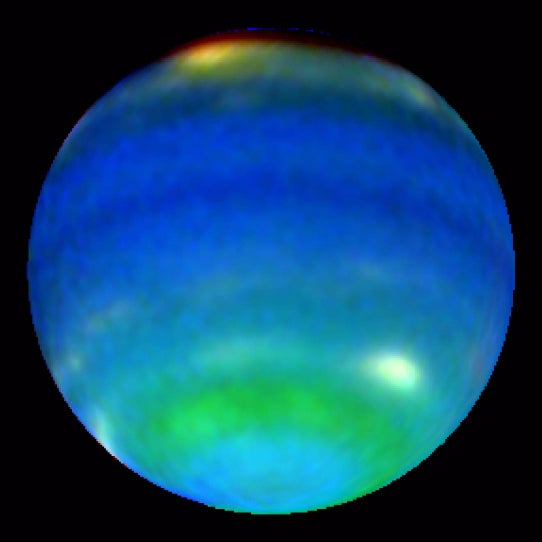Venus and Jupiter hang low in the southwest after sunset this week. Venus, which shines at magnitude –3.9, stands 5° above the horizon 45 minutes after sunset. Jupiter glows two magnitudes fainter than Venus and lies 9° to its neighbor’s upper left, or about the span of your closed fist when held at arm’s length. If you track the two this week, you’ll notice that they appear to be on a collision course. The gap between the planets narrows by 1° each day, setting up a dramatic conjunction at the end of next week.
Saturday, November 16
Although asteroid 4 Vesta reached opposition and peak visibility the night of November 11/12, the Full Moon was only a few degrees away that night and made finding the magnitude 6.5 space rock a serious challenge. Now that the Moon has moved well away — and Vesta shines just as brightly as it did at opposition — locating the asteroid through binoculars should prove much easier. The brightest asteroid lies in northeastern Cetus tonight, 3° west of the 4th-magnitude star Omicron (ο) Tauri and 5° northeast of 3rd-magnitude Alpha (α) Ceti.
Sunday, November 17
The Leonid meteor shower reaches its peak before dawn tomorrow morning. Although typically one of the year’s finer meteor showers, this year’s Leonid display suffers because it comes just a few days after Full Moon. A 65-percent-lit waning gibbous Moon shares the sky with the shower, drowning out the fainter “shooting stars” and rendering the brighter ones less impressive. Still, the Leonids produce more fireballs than most meteor showers, so it is still worth keeping an eye on the predawn sky.
Monday, November 18
Uranus reached opposition and peak visibility three weeks ago, and it remains a tempting target all this week. The outer planet appears in the eastern sky after darkness falls and climbs highest in the south around 10 p.m. local time. The magnitude 5.7 world lies in southeastern Aries the Ram, near that constellation’s border with Pisces the Fish and Cetus the Whale. Although Uranus shines brightly enough to glimpse with the naked eye under a dark sky, use binoculars to locate it initially. The closest guide star is magnitude 4.4 Xi1 (ξ1) Ceti, which lies 3.8° to the south-southeast. A telescope reveals the planet’s 3.7″-diameter, blue-green disk.
Tuesday, November 19
Last Quarter Moon arrives at 4:11 p.m. EST. It rises in the eastern sky shortly before midnight local time and reaches its peak in the south around sunrise tomorrow morning, by which time it appears slightly less than half-lit. Our satellite resides among the background stars of Leo throughout this period, roughly 5° from the Lion’s brightest star, 1st-magnitude Regulus.
If you’re game for a quick evening challenge, try to spot Neptune through binoculars. The distant planet lies halfway to the zenith in the southern sky around 7 p.m. local time and doesn’t set until after midnight. The magnitude 7.9 world appears against the backdrop of Aquarius, 1.5° west-southwest of the 4th-magnitude star Phi (φ) Aquarii. You’ll need binoculars to spy Neptune and a telescope to see its blue-gray disk, which spans 2.3″.
Thursday, November 21
Although Mercury passed directly between the Sun and Earth in a splendid transit just last week, the innermost planet has already climbed into view during morning twilight. Look low in the east-southeast about 30 minutes before sunrise, when Mercury stands 10° above the horizon. The planet shines at magnitude 0.1, so you should be able to see it with your naked eye, at least once you’ve picked it out of the twilight glow with binoculars. When viewed through a telescope, Mercury appears 8″ across and sports a slender crescent phase. The inner world will grow brighter and climb higher as it approaches its greatest elongation a week from today.
Friday, November 22
Although the calendar says November, the Summer Triangle of bright stars remains prominent during the early evening hours. Look nearly overhead after darkness falls and you’ll spot Deneb, a conspicuous point of light despite being the faintest of the three luminaries. Brighter Vega lies west of Deneb and intermediate Altair appears to their south.
Saturday, November 23
Venus’ relentless push higher into the early evening sky coupled with Jupiter’s inexorable fall brings the brilliant planets together after sunset tonight and tomorrow night. The gap between the two worlds stands at 1.5° both evenings — tonight, Jupiter lies above Venus; tomorrow night, Venus appears to the left and slightly below its partner. The best views of this magnificent conjunction will come with the naked eye or binoculars. A telescope at low power can just capture the two in a single field, but the pair’s low altitude means you likely won’t see much detail on either planet.
Saturn remains a glorious sight this week. The ringed planet resides among the background stars of Sagittarius the Archer, a region that appears 15° high in the southwest as twilight fades to darkness and doesn’t set until nearly 8 p.m. local time. Saturn shines at magnitude 0.6 and appears significantly brighter than any of its host constellation’s stars. Although a naked-eye view of the planet is nice, seeing it through a telescope truly inspires. Even a small instrument shows the distant world’s 16″-diameter disk and spectacular ring system, which spans 35″ and tilts 25° to our line of sight.
The waning crescent Moon makes a convenient guide for spotting Mars this morning. Look for the 6-percent-lit Moon about 15° high in the east-southeast an hour before sunrise. The Red Planet lurks 4° to Luna’s right. Although magnitude 1.7 Mars won’t look prominent, you shouldn’t have any trouble seeing it. And while you’re braving the predawn chill, you should also look for magnitude –0.4 Mercury 8° below the Moon.












